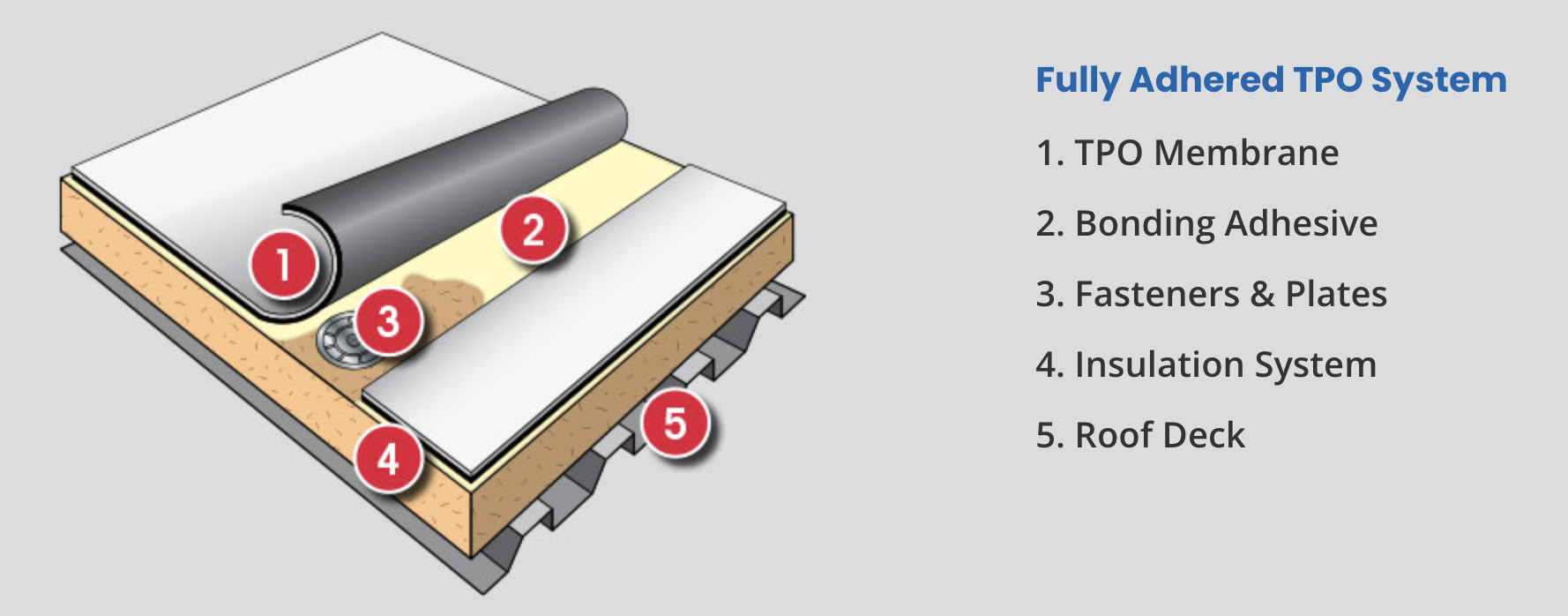You may have come across a bright white roof on large commercial buildings. That’s what we call TPO Roofing System or the common type of single-ply membrane roofing, Thermoplastic Polyolefin. TPO is the go-to selection because it offers great energy savings and it is cost-effective.
In this article, we will cover everything you need to know about TPO roofs. We’ll discuss the benefits, the installation process, and how to care for your TPO roof!
What is TPO Roofing?
TPO roofing is a type of single-ply membrane roofing. This means that it is a sheet of rubber or other synthetic materials that can be ballasted, mechanically fastened, or chemically adhered to the insulation. Single-ply membrane roofing is one of the most well-known types of commercial roofing material.

Perks of TPO Roofing
There are many benefits to choosing TPO roofing for your commercial building. One of the biggest benefits is energy savings! TPO Roofs reflect heat away from the building, which helps keep the inside temperature cooler in the summer months. This can lead to big savings on your energy bills!
Another benefit of TPO Roofing is its durability. TPO roofs are resistant to fire, punctures, and UV rays. They also have a long lifespan, which means you won’t have to replace your roof as often as with other types of roofing materials.
How is TPO Roofing Installed?
The installation process for TPO Roofing is similar to other types of single-ply membrane roofing. First, the area where the roof will be installed must be cleaned and prepped. Then, the membrane is rolled out and secured in place. Once the membrane is in place, it is fastened with either ballast or adhesive.
Here are a few types of insulation options that you can choose from:
-
Polyisocyanurate (Polyiso) – This is the most common insulation material used in roofing applications. Polyiso is more expensive, but it pays off with a higher R-value.
-
Expanded Polystyrene (EPS) – EPS is a highly effective thermal insulator that is used for roof, wall, and floor insulation. EPS can be utilized as ground contact and does not retain water over time.
-
Polystyrene Sheet (XPS) – XPS is a type of extruded polystyrene that falls between Polyiso and EPS in terms of price and performance. With a perm rating of 1, XPS is semi-permeable.
How much does TPO Roofing cost?
Install a typical single-ply membrane commercial roofing system, it will generally cost between $3.50 and $7.50 per square foot in materials and labor for a 20,000 sq. ft. commercial roof.
To get the best rubber roofing prices, you need to consider the following factors:
-
Your roof size
-
The current condition of your roof
-
Accessibility to your roof
-
Insulation type
-
Membrane type
-
Installation method
-
Roof penetrations
-
Warranty type
When to call for repair?
TPO shingles will last around 15-20 years. Seams may break away, flashings may fail, the membrane may be punctured, and so on, resulting in a roof leak.
When water has begun to enter a TPO roof, it’s time to call in the experts. This typically happens as a result of rips in the seams allowing water to seep into the roofing insulation.
A professional roofer will be able to tell during the inspection:
-
Where the water is entering your insulation
-
How old is the TPO roof
-
How many layers does the roof have
-
The condition of the seams
TPO roofs require very little maintenance. You should have a professional roofer inspect your roof at least once a year to check for any damage or leaks. It’s also important to clear away any debris that has accumulated on your roof. This will help prevent water from pooling on the surface of your roof and causing leaks.
In conclusion, TPO Roofing is a great choice for commercial buildings because it is energy-efficient, durable, and easy to maintain. If you are thinking about installing a new roof on your commercial property, Maven can assist you in choosing the right roofing system, preparing project specifications, designs, construction & more!
